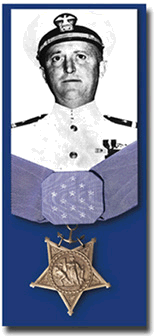The first U.S. submariner to receive the Medal of Honor in World War II, Commander Howard W. Gilmore, lost his life in a selfless act of heroism that has become one of the most inspiring legends of the Submarine Force. Gilmore was born in Selma, Alabama, in 1902 and served first as an enlisted Sailor before entering the U.S. Naval Academy by competitive examination. He graduated from the Academy in 1926, standing 34th in a class of 456. Before the war, Gilmore had served as the executive officer of USS Shark (SS-174), and in a colorful incident during that time, narrowly survived an assault by a group of thugs in Panama, who cut his throat during an excursion ashore. In March 1942, four months after the Japanese attack on Pearl Harbor, he took command of the new USS Growler (SS-215), fourth boat of the 81-ship Gato (SS-212) class and sailed her to the Pacific theater.
Operating out of Pearl Harbor, Growler was one of seven submarines assigned picket duty north and west of the islands as part of the Hawaii defense force during the early phases of the Battle of Midway in June 1942. Later that month, she embarked on her first war patrol in the vicinity of the Aleutian Islands, where Gilmore attacked three Japanese destroyers off Kiska, sinking one and severely damaging the other two, while narrowly avoiding two torpedoes fired at him in return. In early August, Gilmore took Growler on her second and most successful war patrol in the East China Sea near Taiwan, sinking four merchant ships totaling 15,000 tons, before returning to Hawaii in late September.
In October 1942, Growler sailed from Pearl Harbor to Brisbane, Australia, by way of Truk in the Caroline Islands, both to support the blockade of that Japanese bastion and as part of a general re-positioning of submarine assets ordered by ADM Chester Nimitz during the early struggle for the Solomon Islands. Gilmore and Growler scored no kills on this third war patrol but arrived safely in Brisbane in mid-December.
Growler departed Brisbane on New Year’s Day 1943 for her fateful fourth war patrol, targeting Japanese shipping lanes between Truk and Rabaul in the Bismarck Archipelago. On 16 January, Gilmore sighted an enemy convoy, maneuvered inside the escorts, and sank Chifuku Maru, a 6,000-ton passenger-cargo ship. He was unsuccessful in subsequent attacks on a small convoy and a converted gunboat, but on the night of 6-7 February, while charging batteries on the surface, Gilmore spotted the 900-ton provision ship Hayasaki and manned the bridge for a surface attack. With Growler still a mile away, however, Hayasaki’s watch saw the on-coming submarine, and Hayasaki turned to the attack herself, attempting to ram her assailant. As the small ship charged out of the darkness, Gilmore sounded the collision alarm and shouted, “Left full rudder!” – to no avail. Perhaps inadvertently, Growler hit the Japanese adversary amidships at 17 knots, heeling the submarine 50 degrees, bending sideways 18 feet of her the bow, and disabling the forward torpedo tubes.
 |
| Growler's bent bow at Brisbane, Australia, for repairs to her bow, after she rammed a Japanese patrol vessel in the Bismarck Islands on 7 February 1943 |
Surfacing some time later in hope of re-attacking the Hayasaki, Schade found the seas empty. The Japanese ship had, in fact, survived the encounter, but there was no sign of Gilmore, who apparently had drifted away in the night. Schade and Growler’s crew managed to control the ship’s flooding and limped back to Brisbane on 17 February. Taken immediately into dry dock, Growler was repaired and fought again – at first under the command of Lt. Commander Schade, and then under Commander Thomas B. Oakley, Jr. Sadly, she was lost on her 11th war patrol in November 1944, while attacking a Japanese convoy south of Mindoro in the Philippine Islands. Growler received eight battle stars for her role in the Pacific War.
For sacrificing his own life to save his ship, Commander Howard Gilmore was posthumously awarded the Medal of Honor. Subsequently, the submarine tender Howard W. Gilmore (AS-16) was named for him and sponsored by his widow. Even today – over 50 years later – “Take her down!” remains one of the legendary phrases of the U.S. Submarine Force.
 |
| "Take Her Down" Commander Howard W. Gilmore, wounded on the bridge of Growler, orders the submarine to dive |
For distinguished gallantry and valor above and beyond the call of duty as Commanding Officer of the USS Growler during her Fourth War Patrol in the Southwest Pacific from 10 January to 7 February 1943. Boldly striking at the enemy in spite of continuous hostile air and antisubmarine patrols, CDR Gilmore sank one Japanese freighter and damaged another by torpedo fire, successfully evading severe depth charges following each attack. In the darkness of night on 7 February, an enemy gunboat closed range and prepared to ram the Growler. CDR Gilmore daringly maneuvered to avoid the crash and rammed the attacker instead, ripping into her port side at 11 knots and bursting wide her plates. In the terrific fire of the sinking gunboat’s heavy machineguns, CDR Gilmore calmly gave the order to clear the bridge, and refusing safety for himself, remained on deck while his men preceded him below. Struck down by the fusillade of bullets and having done his utmost against the enemy, in his final living moments, CDR Gilmore gave his last order to the officer of the deck, “Take her down.” The Growler dived; seriously damaged but under control, she was brought safely to port by her well-trained crew inspired by the courageous fighting spirit of their dead captain.


No comments:
Post a Comment